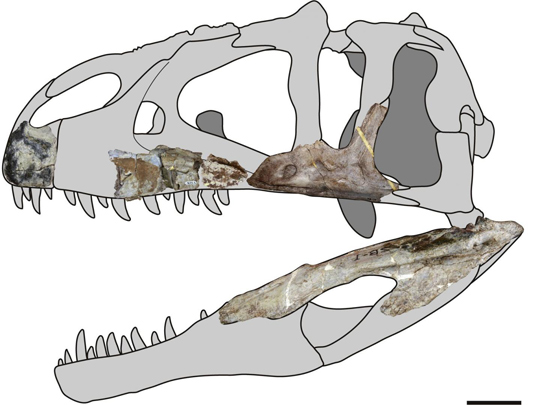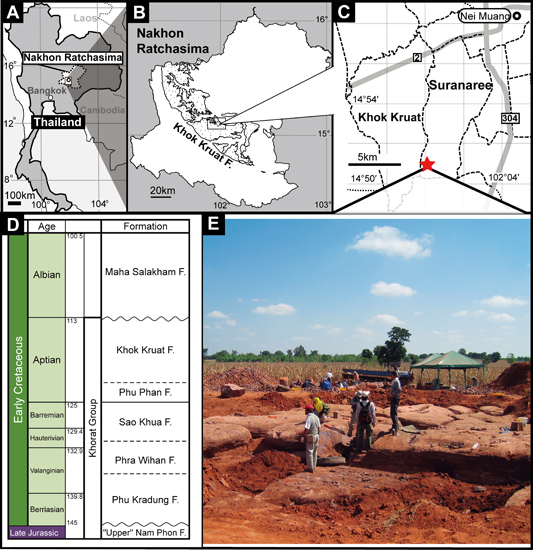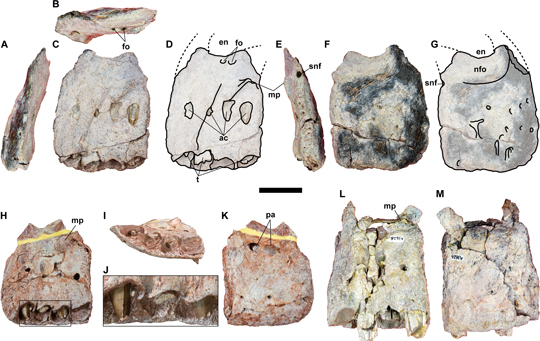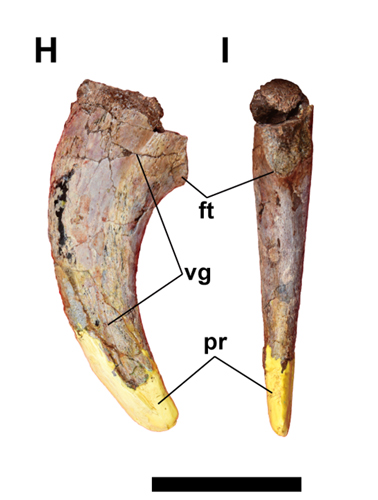A New Basal Carcharodontosaurian the King of Siam – Siamraptor suwati
New Basal Carcharodontosaurian from Thailand – Siamraptor suwati
A team of scientists from Thailand and Japan have announced the discovery of a new species of meat-eating dinosaur from the Early Cretaceous of north-eastern Thailand. The dinosaur has been named Siamraptor suwati and around 115 million years ago, this eight-metre-long theropod would have been the “King of Siam”.
An Illustration of the Skull of the Newly Described Carcharodontosaurian Theropod Siamraptor suwati

Picture credit: Chokchaloemwong et al (PLOS One)
Providing an Insight into the Early Evolutionary History of the Carcharodontosauria
The Carcharodontosauria “shark-toothed lizards”, represent a group of theropod dinosaurs that were both temporally and geographically widespread during the Mesozoic. Some of these dinosaurs were giants, comparable to the largest tyrannosaurids. For example, the genus Carcharodontosaurus is known from the Cenomanian faunal stage of the Late Cretaceous of North Africa, some of the larger fossil specimens indicate a length in excess of thirteen metres.
Then there are the giants from South America, dinosaurs such as Tyrannotitan, Mapusaurus and Giganotosaurus, however, little is known about the evolutionary history of the Carcharodontosauria clade. Writing in the on-line academic journal PLOS One, the researchers state that the discovery of Siamraptor will provide an important insight into the early evolutionary history of the Carcharodontosauria.
A Silhouette of Siamraptor Showing Position of Known Fossil Material

Picture credit: Chokchaloemwong et al (PLOS One)
The Significance of Siamraptor suwati
The fossil material comes from the Khok Kruat geological formation (part of the Khorat Group), in Khorat, north-eastern Thailand an area that has been explored extensively by the Japan-Thailand Dinosaur Project (JTDP) team. The age of the strata from which the Siamraptor fossil material comes is not known, however, pollen fossil analysis and biostratigraphical indicators support an Early Cretaceous age (Aptian faunal stage).
The Location of the Fossil Discovery and a Stratigraphical Column for the Khorat Group

Picture credit: Chokchaloemwong et al (PLOS One)
The picture (above), shows (A) a map of the Nakhon Ratchasima Province of north-eastern Thailand and (B) a distribution map of the Khok Kruat Formation in the area. Picture (C) shows an enlargement of the area where the Siamraptor fossil material was found. The red star in (C) indicates the fossil quarry. A stratigraphical column of the Khorat Group is provided (D) and (E) shows a photograph of the dig site.
A Basal Member of the Carcharodontosauria
Two phylogenetic analyses indicate that Siamraptor was a basal member of the Carcharodontosauria. This taxon is the first definitive evidence of carcharodontosaurian theropods in south-eastern Asia. The fossil material, although very fragmentary and representative of four individual dinosaurs is also amongst the best preserved theropod fossil material known from this part of Thailand.
The presence of Siamraptor in north-eastern Thailand indicates an extension of the record in the Laurasian landmasses during the earliest stage of the evolutionary history of the Carcharodontosauria.
Three Premaxillae Elements Representing Siamraptor suwati

PicturecCredit: Chokchaloemwong et al (PLOS One)
The fossil material includes elements from the jaws, parts of the skull, vertebrae, elements from the hips and hind limbs and a single claw from the hand. With the formal naming of this dinosaur it reveals that the carcharodontosaurids had spread to Asia as well as Europe and Africa by the Early Cretaceous.
The Fossil Manual Ungual (NRRU-F01020018) – Siamraptor suwati

Picture credit: Chokchaloemwong et al (PLOS One)
The genus name translates as “robber from Siam”, whilst the species name honours Mr. Suwat Liptapanlop for his financial support of the fieldwork undertaken in Thailand.
The scientific paper: “A new carcharodontosaurian theropod (Dinosauria: Saurischia) from the Lower Cretaceous of Thailand” by Duangsuda Chokchaloemwong, Soki Hattori , Elena Cuesta, Pratueng Jintasakul, Masateru Shibata and Yoichi Azuma published in the on-line, open access journal PLOS One.
The Everything Dinosaur website: Everything Dinosaur.

